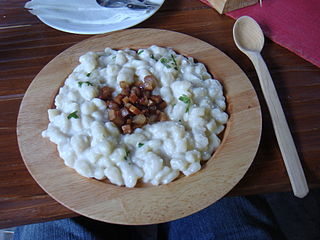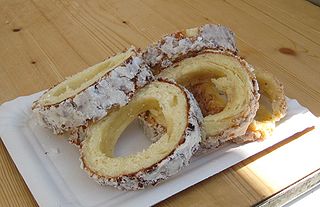
Dessert is a course that concludes a meal. The course consists of sweet foods, such as candy, and possibly a beverage such as dessert wine and liqueur. Some cultures sweeten foods that are more commonly savory to create desserts. In some parts of the world there is no tradition of a dessert course to conclude a meal.

Cake is a flour confection made from flour, sugar, and other ingredients and is usually baked. In their oldest forms, cakes were modifications of bread, but cakes now cover a wide range of preparations that can be simple or elaborate and which share features with desserts such as pastries, meringues, custards, and pies.

Dough is a thick, malleable, sometimes elastic paste made from grains or from leguminous or chestnut crops. Dough is typically made by mixing flour with a small amount of water or other liquid and sometimes includes yeast or other leavening agents, as well as ingredients such as fats or flavorings.

Marzipan is a confection consisting primarily of sugar, honey, and almond meal, sometimes augmented with almond oil or extract.

Shortcake generally refers to a dessert with a crumbly scone-like texture. There are multiple variations of shortcake, most of which are served with fruit and cream. One of the most popular is strawberry shortcake, which is typically served with whipped cream. Other variations common in the UK are blackberry and clotted cream shortcake and lemon berry shortcake, which is served with lemon curd in place of cream.

Baumkuchen is a kind of spit cake from German cuisine. It is also a popular dessert in Japan. The characteristic rings that appear in its slices resemble tree rings, and give the cake its German name, Baumkuchen, which literally translates to "tree cake" or "log cake".

Kuchen, the German word for cake, is used in other languages as the name for several different types of savory or sweet desserts, pastries, and gateaux. Most Kuchen have eggs, flour and sugar as common ingredients while also, but not always, including some fat. In Germany it is a common tradition to invite friends over to one's house or to a cafe between noon and evening to drink coffee and eat Kuchen.

Slovak cuisine varies slightly from region to region across Slovakia. It was influenced by the traditional cuisine of its neighbours and it influenced them as well. The origins of traditional Slovak cuisine can be traced to times when the majority of the population lived self-sufficiently in villages, with very limited food imports and exports and with no modern means of food preservation or processing.

Fondant icing, also commonly called simply fondant, is an icing used to decorate or sculpt cakes and pastries. It is made from sugar, water, gelatin, vegetable oil or shortening, and glycerol. It does not have the texture of most icings; rolled fondant is akin to stiff clay, while poured fondant is a thick liquid. The word, in French, means 'melting,' coming from the same root as fondue and foundry.

Czech cuisine has both influenced and been influenced by the cuisines of surrounding countries and nations. Many of the cakes and pastries that are popular in Central Europe originated within the Czech lands. Contemporary Czech cuisine is more meat-based than in previous periods; the current abundance of farmable meat has enriched its presence in regional cuisine. Traditionally, meat has been reserved for once-weekly consumption, typically on weekends.

Spettekaka or spettkaka is a local dessert of the southern parts of Sweden, chiefly in the province of Scania (Skåne) but also in Halland. It is an important part of the Scanian culinary heritage. The name means "cake on a spit", and this describes the method of preparation: it is the Swedish variation on the spit cake.

Šakotis is a Polish, Lithuanian and Belarusian traditional spit cake, similar to the German Baumkuchen. It is a cake made of butter, egg whites and yolks, flour, sugar, and cream, cooked on a rotating spit in an oven or over an open fire.

Spekkoek is a type of Indonesian layer cake. It was developed during colonial times in the Dutch East Indies. The firm-textured cake is an Indo (Dutch-Indonesian) version of the European multi-layered spit cake. However it is not baked on a rotating spit, and contains a mix of Indonesian spices, such as cardamom, cinnamon, clove, mace and anise. The cake is made of flour and yolk and is rich in butter or margarine.

Kürtőskalács is a spit cake specific to Hungarians from Transylvania (Romania), more specifically the Székelys. Originally popular in the Hungarian-speaking regions of Romania, more predominantly the Székely Land, it became popular in both Hungary and Romania. The first written record dates back to 1679 and was found in the village of Úzdiszentpéter, while the first recipe appears in a manuscript cookbook dated in 1781. Earlier a festive treat, now it is part of everyday consumption. In Transylvania, a similar pastry to Kürtőskalács is Baumstriezel, originating in the Saxon communities.

Trdelník is a kind of spit cake and variant of Kürtőskalács. It is made from dough that is wrapped around a stick, then baked and topped with sugar and walnut mix.

Mekitsa is a traditional Bulgarian dish made of kneaded dough made with yogurt that is deep fried. They are made with flour, eggs, yogurt, a leavening agent, water, salt, and oil. In Serbia they are called mekike, while in Macedonian mekica or pituljica, and in Bulgaria mekitsa. They are similar to Hungarian lángos and British Yorkshire pudding. Mekitsa is conventionally a breakfast dish.




























